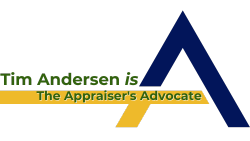USPAP’s ETHICS RULE contains three major sections. It is the purpose of this blog to treat its Conduct section in more detail.
In the introduction to the CONDUCT section, we read this unambiguous statement: “An appraiser must perform assignments with impartiality, objectivity, and independence, and without accommodation personal interests.” Therefore, it makes sense to define all three of these terms. USPAP does not define them so the” standard definition” (whatever that is) of the words are also applicable in a USPAP context.
According to the Cambridge English Dictionary, the definition of impartial is “[A]ble to judge or consider something fairly without allowing your own interest to influence you”. Therefore, impartiality is the state of being able to judge or consider something fairly, without allowing outside interest(s) to be of influence.
According to the definition, someone who is impartial judges without considering extraneous influences. An impartial appraiser, therefore, depends on the facts the market presents, those s/he has verified.
A competent appraiser gathers facts, verifies them, and analyzes them to determine which are relevant. Then, without outside influence, the appraiser decides which of the relevant facts apply to the marketability and the market value of the subject, and then interprets those facts in that light. So, appraisers follows the facts to where they lead; the appraiser does not push them where the appraiser wants them to go.
An egregious, but every-day example of this, is reviewers demanding the appraiser make an adjustment when, in light of the facts, no adjustment is necessary. For example, reviewers commonly demand that an appraiser make an adjustment every time the site of a comparable sale has a different size than does the subject site. However, this begs the question the market is buying square footage, rather than location. While this is occasionally true, it is not a universal. Therefore, demanding an appraiser make a size adjustment, when it is clear the market buys lots, not square footage, is the reviewer asking the appraiser to push the appraiser’s conclusion to an area the facts do not support. The reviewer in this in this case in advocating for the client, a blatant USPAP violation. Hooray for impartial, objective, and independent appraisers!
That same source defines objectivity as, “[T]he fact of being based on facts and not influenced by personal beliefs or feelings”. Appraisers should not concern themselves with feelings, intuitions, or impressions, be those their own or those of others. Rather, they deal objectively with the market’s own facts.
In real estate brokers objectivity is not a positive trait. Brokers advocate for their clients. Their job is to sell something; our job is to analyze something, a higher calling. We seek facts and information from all sources (including brokers). Nevertheless, we must analyze those facts and that information considering what else the market tells us, while we ignore the broker’s inherent lack of objectivity and blatant cheer leading for a high value (thus a high commission).
This does not mean we cannot accept the broker’s information. Nevertheless, it means that we look at this information critically and objectively. Does it truly reflect the market’s verities, or is it is self-serving propaganda from one with an agenda?
This same dictionary defines independence as, “[T]he ability to live your life without being helped or influenced by other people”. Nevertheless, for real estate appraisers, it is both wrong and a highly unethical to receive such help and influence uncritically and/or non-objectively. That is why we must be independent of the influence of others. We depend on our own judgment and execution as the foundation of our professional competence, not those of others.
One example of this is that for years appraisers tended to limit their adjustments (especially relative to size adjustments) to “rules-of-thumb”. Some appraisers erroneously believed that the GSE’s limited adjustments both to a certain quantity, as well as a certain net size. This was never true. The GSE’s do ask appraisers to explain, with support from the market, extraordinarily large adjustments or extraordinarily numerous adjustments. However, the GSE’s have never had any such rules or guidelines. This would limit the quality of the appraiser’s analysis of the market which, in the long run, would serve to the detriment of the GSEs.
To sum up then, the appraiser must conduct him/herself in a manner that is independent, impartial, and objective. This requires critical thinking, as well as critical analyses of the facts. It involves accepting data and information from all sources, but then analyzing those critically and objectively to determine which are relevant, which are irrelevant, and which are mere propaganda. As we do so, we comply with USPAP’s rather lofty purpose, which is “…to promote and maintain a high level of public trust in appraisal practice…”.

